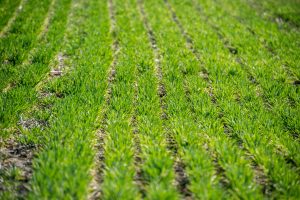Agronomy, Homepage Slider, Water Quality
Reducing Nitrogen Runoff
Adapted from an article by James Hoorman, Hoorman Soil Health Services
Keeping nitrogen in the soil should be a major goal of every farmer, so keeping N in a form that is both plant available but not soluble would be a great accomplishment. Soil N runoff is lost at 100X higher rates than soil phosphorus and N is a major pollutant in Lake Erie and the Mississippi River. Microbially bound N is both plant available but also not soluble. When soils get dry, N is often not plant available but when these soils finally get wet, the soluble N can be lost by leaching or denitrification. The best way to reduce these problems is to convert soluble N to amino acids to keep the soil N from being lost. So healthy soils keep our nutrients recycling, plant available, and result in less nitrogen pollutions (less N runoff or N lost as atmospheric gases).
Soil microbes need three things to tie up nitrogen as amino acids: carbon, sulfur, and molybdenum. A typical carbon to nitrogen (C:N) ratio of 30:1 is needed to stabilize soil nitrogen. Carbon is the skeleton or backbone to tying up N in the form of amino acids and proteins. The best way to make sure adequate carbon is available especially on sandy soils is to grow a cover crop; especially grass cover crops like cereal rye, oats, annual ryegrass, triticale etc.

Grass roots produce sugars and carbohydrates which supply he carbon needed to stabilized soluble N. When nitrogen fertilizer is applied in the spring, adding stable humic products at a 3% rate ties up soluble N. Soil organic matter or humic products have the ability to tie up negative charged anions like nitrates and keeps soil N from being lost as pollutants.
Sulfur (S) is another element used by soil microbes to make essential amino acids like cysteine and methionine. The soil ratio is 10 parts nitrogen to one-part sulfur (10:1 N:S ratio). A simple remedy for keeping N tied up is to apply S at the same time that N fertilizer is applied. For a simple example, if your soil nitrogen levels are 60# available N/acre and you apply 60# N fertilizer, you have a total of 120# N/acre. If a soil test indicates only 8# of available sulfur, farmers need to apply 4# S to get a 10:1 N:S ratio because 120# N needs 12# S to stabilize the N. Farmers often add ammonium thiosulfate (12% N, 26% S) at planting in their starter fertilizer to stabilize the N. Another source of sulfur is gypsum (calcium sulfate) which is 23% calcium and 18.5% sulfur. Due to the Clean Air Act, farmers are not getting sulfur for free like they did 20 years ago.
Molybdenum (Mo) is a micronutrient needed to keep nitrogen from being lost. The nitrogen reductase enzyme needs Mo to convert nitrates into amino acids. Sandy soils and soils that are acid (low pH) generally have shortages of available Mo, so liming improves Mo availability. Adding 1 pint/acre of Mo can greatly increase N microbial uptake and amino acid formation, stabilizing soil N.
Another strategy uses microbial bio stimulates to promote beneficial bacteria which tie up soluble N fertilizer. When concentrated N fertilizer is applied to the soil, the beneficial bacteria often cannot survive in this environment. Soil organic matter, humic acids and microbial bio stimulates not only buffer the soil, but also allow these beneficial bacteria to thrive, so that the N is used more efficiently. Microbial bio stimulates also contain complex carbohydrates like molasses and other simple sugars which may provide another microbial carbon source. An added benefit is that these microbial bio-stimulates help break down crop residues and improve soil structure and drainage. Nitrogen inhibitors may also be used to inhibit nitrogen transformations but are generally slightly more expensive. Utilizing humic acids, sulfur, molybdenum, and microbial bio stimulates along with cover crops utilize natural processes which keep soil nitrogen recycling effectively.